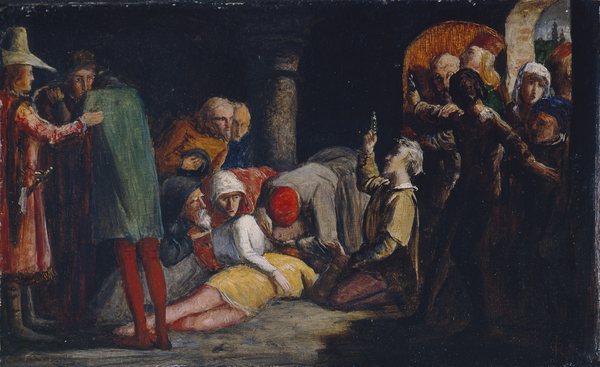The Death of Romeo and Juliet
Sir John Everett Millais 8 Jun 1829 - 13 Aug 1896
Summary
Loosely painted scene from Romeo and Juliet, depicting a moment from Act V, Scene 4 in which the lovers are found dead in the Capulet tomb. The various figure groups are arranged as a tableau, with Romeo and Juliet in the centre of the composition; the body of Romeo, dressed in a yellow tunic, is partially covered by that of Juliet, in a white gown. Five figures gather around the bodies as one of them places their hands at Juliet's throat, as if in search of a pulse; a sixth figure, kneeling to the right of the bodies, holds up a phial of poison. To the left is a group of three grieving family members. To the right, a group of figures crowd at an open door, which reveals a nighttime cityscape beyond. The entire scene is illuminated only by the open door and light cast from the outside.
Display Label
Gallery text panel The Pre-Raphaelites in their Time Britain's first and best-known radical art movement emerged from within the Royal Academy in 1848. Its original members were rebellious art students who were disillusioned with contemporary practice. They looked back to Italian art before Raphael, seeing the pre-1500 period as one of great sincerity. They called themselves the Pre-Raphaelite Brotherhood. In an age of rapid industrial and urban expansion, Pre-Raphaelite artists like Rossetti, Hunt and Millais, and pioneering design reformers such as William Morris, sought a return to pre-industrial values of art and design in truth to nature and materials, and good workmanship. In addition, the arts of the Middle Ages and Middle East were important sources of stylistic inspiration. The Bible, literature and contemporary life were preferred over subjects derived from classical mythology. The Brotherhood also rejected contrived studio lighting and took canvases outside to paint directly from nature. Although attempting to convey exactly what they saw, they created a heightened reality of dream-like intensity with minute details and bright, dazzling colours. Their art was a new kind of history painting for a new age.
Object Name
The Death of Romeo and Juliet
Creators Name
Date Created
1848 (circa)
Dimensions
Canvas: 16.1cm x 26.9cm
Frame: external dimensions: 30cm x 37.5cm
accession number
1947.89
Place of creation
England
Support
Millboard
Medium
Oil paint on millboard
On Display
[G7] Manchester Art Gallery - Gallery 7
View all
Credit
George Beatson Blair bequest, 1941.
Legal
© Manchester Art Gallery

